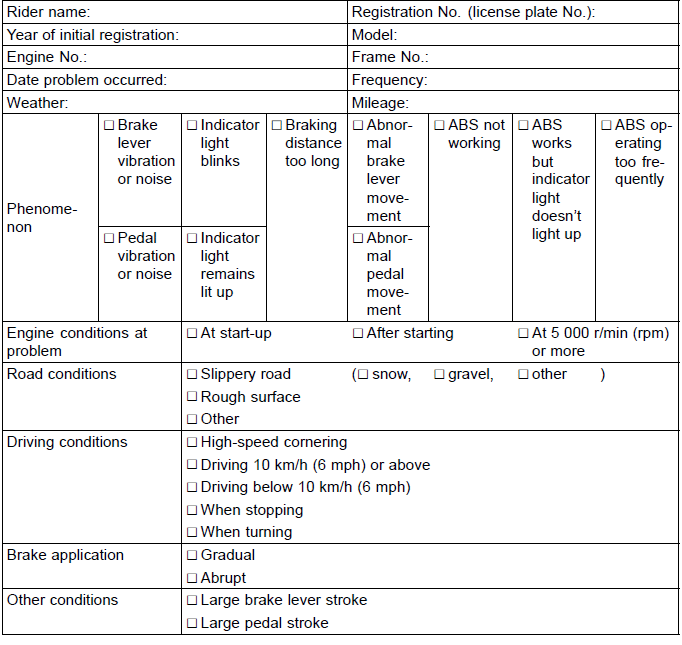 Kawasaki Z1000SX - Service manual > Inquiries to Rider
Kawasaki Z1000SX - Service manual > Inquiries to Rider
- Each rider reacts to problems in different ways, so it is important to confirm what kind of condition the rider is dissatisfied with.
- Try to find out exactly what problem occurs under exactly what conditions by asking the rider; knowing this information may help you reproduce the problem in the shop.
- The diagnosis sheet will help prevent you from overlooking any keys, so always use it.
Sample Diagnosis Sheet

Pre-Diagnosis Inspection 1

Pre-Diagnosis Inspection 2

Self-diagnosis Outline
When the indicator light has blinked or come on, the ABS hydraulic unit memorizes and stores the service code (17 codes including "Normal Code") for the service person to troubleshoot easily. The service code memory is powered directly by the battery and cannot be canceled by the ignition switch.
The ABS hydraulic unit can memorize up to all service codes (17 codes). Further service codes are memorized after erasing the preceding all service codes (17 codes). If there is no fault, only the start code 12 is shown, indicating that "The ABS is normal".
Self-diagnosis Procedures
- When a problem occurs with the ABS system, the ABS indicator light (LED) [A] lights.
NOTE
- Use a fully charged battery when conducting self-diagnosis. Otherwise, the light blinks very slowly or doesn't blink.
- The motorcycle is stopped.
- Keep the self-diagnosis terminal grounded during self-diagnosis, with an auxiliary lead.

- Remove the rear seat (see Rear Seat Removal in the Frame chapter).
- Turn on the ignition switch.
- Ground the self-diagnosis terminal [A] (Gray) to the battery (-)
terminal, using a suitable lead.
- Count the blinks of the light to read the service code.
Keep the auxiliary lead ground until you finish reading the service code.
- Count the blinks of the light to read the service code.

See also:
 Kawasaki Z1000SX - Service manual > ABS Servicing Precautions, ABS Troubleshooting Outline
Kawasaki Z1000SX - Service manual > ABS Servicing Precautions, ABS Troubleshooting Outline
ABS Servicing Precautions There are a number of important precautions that should be followed servicing the ABS system. This ABS system is designed to be used with a 12 V sealed battery as its power source. Do not use any other battery except for a 12 V sealed battery as a power source. Do not reverse the battery cable connections. This will damage the ABS hydraulic unit. To prevent damage to the ABS parts, do not disconnect the battery cables or any other electrical connections when the ignition switch is ON or while the engine is running. Take care not to short the leads that are directly connected to the battery positive (+) terminal to the chassis ground. Do not turn the ignition switch ON while any of the ABS electrical connectors are disconnected. The ABS hydraulic unit memorizes service codes. Do not spray water on the electrical parts, ABS parts, connectors, leads and wiring. If a transceiver is installed on the motorcycle, make sure that the operation of the ABS system is not influenced by electric wave radiated from the antenna. Locate the antenna as far as possible away from the ABS hydraulic unit. Whenever the ABS electrical connections are to be disconnected, first turn off the ignition switch. The ABS parts should never be struck sharply, as with a hammer, or allowed to fall on a hard surface. Such a shock to the parts can damage them. The ABS parts cannot be disassembled. Even if a fault is found, do not try to disassemble and repair the ABS parts, replace it. The ABS has many brake lines, pipes, and leads. And the ABS cannot detect problems with the conventional braking system (brake disc wear, unevenly worn brake pad, and other mechanical faults). To prevent trouble, check the brake lines and pipes for correct routing and connection, the wiring for correct routing, and the brakes for proper braking power. Be sure to check for fluid leakage, and bleed the brake line thoroughly.
 Kawasaki Z1000SX - Service manual > Service Code Clearing Procedures
Kawasaki Z1000SX - Service manual > Service Code Clearing Procedures
Start the service code erase mode with the following procedure. The erase mode starts when the ABS self-diagnosis terminal is disconnected from the ground terminal after starting the self-diagnosis mode. The service code can be erased by grounding and ungrounding (each time for at least one second) the ABS self-diagnosis terminal three times within about 12.5 seconds after starting the erase mode. The ABS indicator light (LED) remains lit during the erase mode. After erasing, the ABS indicator light (LED) blinks and lights. Once erasing is finished, enter the self-diagnosis mode again to confirm that the service codes have been erased. If the ABS has been reset and all codes have been erased, only start code 12 will be shown.
 Rider's Manual BMW R 1250 GS GSA
Rider's Manual BMW R 1250 GS GSA Owner's Manual Harley-Davidson Sportster XL1200X Forty-Eight
Owner's Manual Harley-Davidson Sportster XL1200X Forty-Eight Owner's Manual Honda CBR650R
Owner's Manual Honda CBR650R Service manual Honda CBR650
Service manual Honda CBR650 Owner's Manual Honda PCX125
Owner's Manual Honda PCX125 Owner's Manual Kawasaki Z1000SX
Owner's Manual Kawasaki Z1000SX Service manual Kawasaki Z1000SX
Service manual Kawasaki Z1000SX Owner's Manual Lexmoto Echo
Owner's Manual Lexmoto Echo Owner's Manual Royal Enfield Interceptor 650
Owner's Manual Royal Enfield Interceptor 650 Service manual Royal Enfield Interceptor 650
Service manual Royal Enfield Interceptor 650 Owner's Manual Yamaha MT-07
Owner's Manual Yamaha MT-07